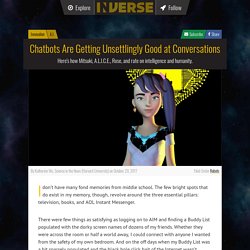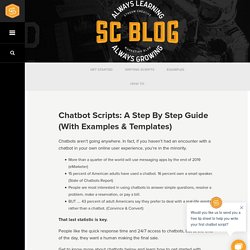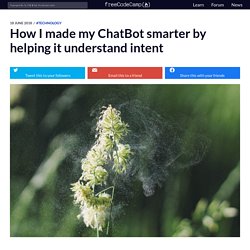

Best Chatbot: Testing ALICE, Cleverbot, Rose, and more. I don’t have many fond memories from middle school.

The few bright spots that do exist in my memory, though, revolve around the three essential pillars: television, books, and AOL Instant Messenger. There were few things as satisfying as logging on to AIM and finding a Buddy List populated with the dorky screen names of dozens of my friends. Whether they were across the room or half a world away, I could connect with anyone I wanted from the safety of my own bedroom. And on the off days when my Buddy List was a bit sparsely populated and the black hole click bait of the Internet wasn’t enough to hold my attention (sorry, Al Gore), there was always SmarterChild.
SmarterChild was an AIM chatbot for the lonely and uninformed. The days of SmarterChild are over, but chatbots are alive and well – perhaps more literally than ever. Cool? The future of artificial intelligence remains a topic of hot debate among programmers. How to Build an Easy, Quick and Essentially Useless Chatbot Using Your Own Text Messages. Construire un bon analyzer français pour Elasticsearch. Dans un index de recherche tel qu’Elasticsearch, une recherche full-text est une simple collecte de documents, qui s’effectue via une comparaison de tokens.

Ces tokens vivent dans l’index inversé et ont été extraits du contenu de vos documents lors de l’indexation. Plus vos tokens sont proprement indexés, et plus facilement un utilisateur trouvera vos documents : c’est le rôle de l’analyse. Cet article va vous guider dans la conception d’un analyzer Elasticsearch pour la langue française qui soit à la fois tolérant, pertinent et rapide – et bien meilleur que l’analyzer « french » fourni par défaut dans le moteur de recherche. TL;DR: Si vous voulez directement la configuration à copier / coller, cliquez ici ! L’importance de l’analyse Prenons un document type pour commencer : le burger 🍔. Avec l’analyse par défaut (appelée « standard »), notre index va être constitué des mots simplement mis en minuscule. Elasticsearch, DialogFlow, Botkit the three musketeers of developing a Chatbot.
Chatbots are now becoming a growing trend with all tech giants rolling out AI assistants like Google Assistant and Siri and many more like them, even startups are coming up with creative solutions for creating chatbots with just a simple ‘drag and drop’ similar to building websites using WordPress or WIX.

Me being a coder find in more in my control to create chatbots or websites through code as it gives me a lot of customizability and modularity over any system which I develop. The startup I work at OrderStack, my best friend and I are working on developing a platform for restaurants, and we call it the OrderStack platform of which the chatbot is a part of.
The chatbot we developed is for targeting customers on the Messenger Platform of Facebook, which skipped our major concern of a chat interface helping us to focus on the features of the chatbot. This tedious task/obstacle led us to find.Musketeer #3 -“Botkit” Chatbot Dialogflow : Contrôlez votre domotique avec votre Google Home ! - Geeek.org. Chatbot Scripts: A Step By Step Guide (With Examples & Templates) It’s easier than you think to get started with a chatbot script.

The most important thing you need to remember is that chatbots are for filtering, not for closing sales. Best chatbot examples for websites- Collect.chat. Maintaining Context in Chatbots - Chatbots Magazine. One of the harder problems that chatbot developers face is how to maintain the context of conversation.

While all the popular frameworks provide an opinionated take on how to maintain this context, none of them seem to be either simple or complete. At ThoughtSpot we built Spot, a bot to get insights into your data. We used a reactive approach to maintain the conversation context. This can be summarised as: Whenever the bot send a message, set(push) <a matcher method m(), a context callback> on the stack.On receiving a message, match the message using the matcher methods in FIFO order. The elegance of this approach is that the pushed callback captures the state of variables as a part of its closure context. Learn designing NLP for Chatbots - Phani Marupaka - Medium. Bots have a knack of retaining knowledge and improving as they are put to greater use.

They have built-in natural language processing (NLP) capabilities and are trained using machine learning techniques and knowledge collections. Just like humans evolve through learning and understanding, so do bots. Say something to a bot and the bot breaks down your utterance into words and phrases to understand what you mean… just like humans detect your intentions through the words used to express them.
You interact with bots to get things done — actions you want the bots to perform, tasks you want them to complete. Actions are described by verbs — fetch something. In the realm of natural language processing, the goal of the user is called an ‘intent’ and that something is an ‘entity’ — modifies an intent, could be a name, place, thing, location, time etc. Utterance (goal) -> Fetch weather reportIntent -> FetchEntities -> weather, report. Why your Chatbot needs to Care about Context - Chatbots Magazine.
Have you ever listened to an adult talk to a small child?

Their tone shifts, they use shorter words and sentences. They repeat the same phrases, “Look at the dog Billy, do you see the dog? How I made my ChatBot smarter by helping it understand intent. By P.
